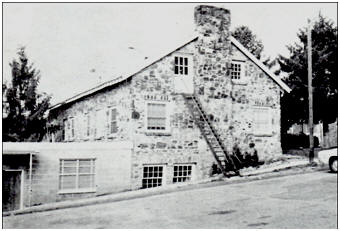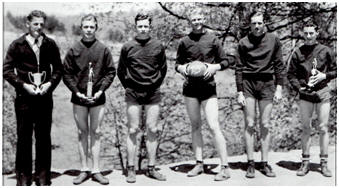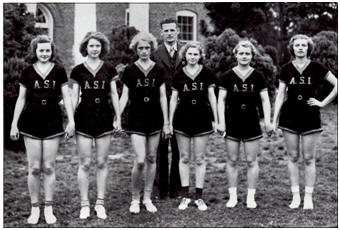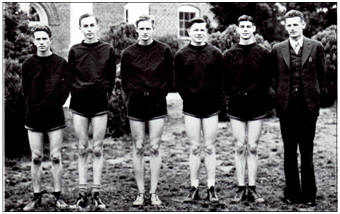
A HISTORY OF ALEXANDER SCHOOLS,
INC. Taken from
A History of Alexander
Schools, Inc. – The First Fifty Years – 1925- 1975
1935-1945 – The Second Decade
Mr. Finley, the first Agriculture teacher, left after two years, and Mr. Cooper came and has been here ever since though he retired in May of 1975. Space was at a premium and the teaching of agriculture was done in a basement room opening to the back of the administration building. Across the hall from this room, Mrs. John Riland, a community lady, taught weaving. Some matrons and community ladies took this course.
After one year Mr. Cooper moved his teaching to the first floor at the end of the gymnasium. The following year the agriculture building was erected and the department has been in it ever since.
About 1941, the government was helping schools operate canneries in the summer. It offered free equipment for such to be done. Our school grasped the opportunity and received the equipment, but we had no building for such. Therefore Mr. Cooper carried on in the basement of the Home Ec. Building for two years. The labor was given for the National Youth Administration to do the work, so the school bought material for a building and the NYA constructed it. This cannery was used by the community as well as the school. War was going on at that time and people wanted to con-serve all the vegetables and fruits they could. (Fruits were grown by individual farmers in those days.) Large quantities were brought to the cannery, which put up a thousand cans a day sometimes. This building got so hot in a fire a few years later – when the building was partially burned – that for a day or two cans could be heard popping open.
This building is still in use, though the cannery business has long been abandoned. It is now used for a shop for the maintenance man. Mr. Howard Monteith used it for years as long as he lived, and since then when Mr. Leroy Young used it.
Home Economics has been taught in the school since the first two years of its existence and was taught in Round Hill Academy before that. This teaching was done in the administration building except for the first two years Miss Johnson was here. In the late thirties, about 1939, with the help of the Works Progress Administration, a rock building was erected for the teaching of home economics. (The NYA and WPA were programs set up by the government during those years of depression to give people work. Since the government was paying them, their labor was free to anyone who could use it.) This building had two stories and a basement that was usable. The main floor was used for home economics, and the top floor for the business department, taught for years by Miss Florence Reid. The basement was used for various purposes and is still being used.

HOME ECONOMICS BUILDING
The first teacher to use the Home Ec. Building was Miss Edith Johnson (now Mrs. J.M. McCarthy of Elgin, Ill.). She left in ’42 and was followed by Mrs. Withrow of Forest City. Then in ’46, Miss Pearl Gold came, and in a few months became Mrs. Ben Barnette and has been here ever since.
The Round Hill Academy reunion was held at Alexander during the summer of ’39. Some of those who attended had been heard of by the workers on the campus since they had been here and were anxious to see them. One of special interest was Miss Meldona Livingston, who had been a most outstanding teacher and leader. She is frequently referred to now by those she taught. The first reunion was of such success that they have one every year now. They meet in the school auditorium for their business session and then have dinner in the dining hall. Of course many of their members are gone, but about a hundred attend this meeting every year.
The English department felt the need for a school paper; hence one was begun by the senior class of 1935. The first editor-in-chief was Victor Workman. This paper served to further school spirit, give the pupils another reason for writing, and let everybody know what was going on the campus. Each class in high school was asked to have a reporter. Anyone who wished to do so could contribute an article. One page was later used for cartoons, and it was surprising how well they were done.
This first editor-in-chief has been very loyal to the school. He became the first president of the alumni association and led this association to have the painting of Mr. Sweatt made which hangs in the school auditorium. He is now married and lives in Asheville. He and his wife have one child, Victor, Jr.
The class of ’41 made the first school annual. This class had five postgraduates in it. One of these, Junior DeBerry was the president of the class. He later joined the navy and was lost at sea. The first book was a small, paper back one, but it set in motion a practice that has continued until now. More recent ones have been much more elaborate.
Each class for a number of years left some remembrance to the school. Recently a member of the class of ’41 visited the campus and said his class gave the rock walls which mark the West entrance to the campus. This was James (Jimmy) Barrow of Columbia, S.C. He said that one other boy and he helped the fore-man construct the walls – one on each side of the road. Each wall has a tall post and a shorter one behind it. On top of these was an electric lamp, but the walls served as places to play for the children, and after a few years the lamps were torn up and the wires had to be removed. Other classes left other mementos also.
In the Alexandrian of April 11, 1935, this article appeared: “Improvements are being made to the grounds of Alexander Schools. Sidewalks are being paved, dormitories repaired, banks sodded and the shrubbery rearranged. The fences of former days are being replaced by rock walls.”
In another one of February 19, 1947, Kenneth Henderson was writing a summary of Mr. Sweatt’s training activities. He spoke of his graduating from Furman University, Greenville, S.C., and from the National Training School, doing his Master’s work in the New York School of Social Work. Later he took work from the University of North Carolina and National Training School for Executives, Debbes Ferry, New York. Among other things that had increased since Mr. Sweatt had been here, Kenneth mentioned that he said when he came “there were only sixteen students enrolled. Now we have over three hundred.”
In those days as soon as school was out, many of the boys who did not have duties to perform would take off to the woods to play. There they would build houses sometimes on the ground and sometimes in trees. Just climbing the trees was fun until one fell and broke an arm. The writer does not recall that one ever broke a leg, fortunately. At times they hiked to the mountains. Usually that was on Saturday when they had more time. The girls also climbed the mountain. Rocky Face was the nearest mountain. If they went to the Pinnacle they needed a ride, but some walked a few times. Swimming in the river was another enjoyable sport before the swimming pool was built in the early forties. Occasionally one, especially the boys on a warm day in the winter, would dive in anyway. One boy did that during the Christmas holidays, and because of it he developed pneumonia and almost died. He did not regain his strength or weight (and he was a heavy boy) before he left the school in the spring.
Several of the boys had chicken pens and bought eggs or small chickens from the neighbor ladies and raised them. Aaron Boggs of Charlotte was a good at that. He often went to Mrs. Holler and bargained for chickens. She was very kind to him and he never forgot her for it. Whenever he came back to homecoming years afterwards, he always brought her a gift as long as she lived.
Another interesting sport was raising rabbits. Woodrow Fountain was a leader in that. He put up a tall wire fence back of the first baby cottage at the edge of the woods and inside built his hutches. He was helped in his effort by Norman Ennis, another Savannah, Ga. Boy. At one time they had as many as a hundred rabbits. They tried to get enough of eatable size to serve the dining hall, but they never succeeded; therefore they served one side of the dining hall at a time.
Coach Smith left in ’38 and Coach Lance came. The ball field had been worked on several times to get it perfectly level, but no one had succeeded. Mr. Lance made another effort and did succeed very well. Then a grandstand was erected on one side so that spectators could sit and also be out of the way. He secured suits for the football teams and had hard-working teams who matched very well the other teams in the county and sports area. He also had basketball teams – both boys and girls – though a lady teacher worked with the girls. They won many honors in the tournaments.
The following account is given by Mr. H.N. “Pop” Lance who coached basket ball and baseball during the years he taught at ASI in the late thirties and early forties: “Thirty years have gracefully slipped by since I handled teams at A.S.I., and many details have long ago faded from my mind.
Girls’ Basketball: Marjorie Flack, Lillian Briscoe, Betty Lord, Mildred (Sweet Pea) Brooks, and the two Williams sisters (Iva and Bernice) developed into one of the best teams in the county. They played fifty-six games together without a defeat. A sports writer saw a game one night, and his comments were ‘Pop Lance has one of the most destroying outfits I know of. He has a tall, blond forward that can shoot anywhere and every-where, and she is backed up by two smooth girls almost as good.’ The two Williams and Mildred Brooks were the best trio of defenders I have coached. They were quick and nimble and could think. This team moved on and the others who succeeded them were faithful. Hattie Lord and Marjorie Tyson and others whose names I have forgotten were not as tall as the first six; and it takes height to compete in basketball. Then there was the mascot, a small blonde head whose name was Alice Ratchford. She was quite efficient in her duties and was liked by members of the squad.
Boys’ Basketball: The first team I had did not do so well, but we had a good time. Shorty (Cameron) Barnes, Lowell Nanney, Billy Scruggs, and others gave a good account of themselves. Many of these graduated and along came Yates Tate, Junior DeBerry, ‘Pip’ Kistler, Lon Oliver, John Howard, George Wiseheart, the two Hall boys (G.A. and Daniel), Bill Scruggs, Bruce Condrey and other I wish I could recall. Yes, I must not forget Jimmy Barrow and the first game he was in when he shot a goal for the other team. He developed into one of the best, and after graduation enlisted in his country’s fighting forces and distinguished himself as a paratrooper. He now represents the Southern Bell Telephone and resides in Columbia, S.C. Then there was Morris McClelland and Bill Tillis, very dependable guards. Then Jim Kelly came in for some glory.
These boys entered the tournament at Valdese three years. They did not win, but were second and won sixty per cent of the trophies.
The boys’ basketball teams would play around thirty-two games per year and would win thirty.
Baseball: With Yates Tate, John Howard, Eustace McAuley, Paul Shirley, Tommy Freeman, Stanley Garrett, and James Conn, and others whose names have slipped, we had teams that did very well. I do not remember about who won and who lost, but we always won more than we lost.”
Mrs. Lance was a matron for the largest boys. They are both now retired and live near Hendersonville. Recently she won the honor of being Woman of the Year in the VFW Auxiliary. She has served six years on the state board of the tuberculosis association, is now a member of the executive board of the WNC Lung Association. She was active in retaining the sanatorium at Black Mountain and visits regularly with the patients. She is a member of the First Baptist Church and teaches a Sunday school class. She was the organizer of the Fruitland Alumni Association.

1935 SECOND-PLACE TOURNAMENT WINNERS IN COUNTY: Front
row: Nancy Holler, Laura Jo
Barnes, Sadie Earnhardt, Virginia Queen;
Second row: Virginia
Briscoe, Lucille Allen, Martha Bridges, Allah Flack, Eva Mae Ferguson

1937 BOYS BASKETBALL:
Coach Smith, James Knight, Bill
Stallings, John Watson, Irvin Bridges, Douglas Henderson.
(note the trophies)

1937 GIRLS BASKETBALL:
Front row: Della Mae
Mann, Henrietta Helmken, Virginia Queen;
Back Row: Iva
Williams, Ethel Edney, Virginia Beeker, Mildred Brooks (Sweet Pea), Mildred
Flack

1938 Basketball team:
L to r:
Betty Lord, Lillian Briscoe, Marjorie Flack, Mildred Brooks, Iva Williams, Ethel
Edney

1938 BASKETBALL TEAM:
L to R:
J. E. Flack, Cameron Barnes, Irvin Bridges, Shirley Owens, Yates Tate, Coach
Smith

1938-1939 BASKETBALL TEAM:
(names not available)

CLASS OF 1935:
First row: Ruth Miller, Clair Belle Craig, Virginia
Briscoe, Laura Jo Barnes, Nancy Holler, Ruby Cowan, Neil Miller;
Second row: Euna Lee Krause,
Lono Morgan, Dorris Turner, Sadie Earnhardt, Winnie B. Clements, Mary Ellen
Watson; Third Row:
Richard McRee, Lucille Allen, Elizabeth Holler, Alla Flack, Fay
Williams; Fourth fow:
Mr. Sweatt, James Scarboro, Victor
Workman

CLASS OF 1936:
First row: Gladys
Cochran, Marie Strickland,
William Bryan; Second
row: Eva Mae Ferguson, Martha Bridges, Ellen Abernethy, Clyde Baity, Guy
Daves; Third row:
Jesse Miller, Dewey Parker, Frank Bartles, Herbert Fleetwood, Albert
(Pete) Aiken, Leroy Cochran;
Fourth row: Worth Johnson, Mr.
Sweatt, Dewitt Brandon

CLASS OF 1937
First row: John
Aiken, Woodrow Fountain, Ann Cochran, Evelyn Krause (Mascot), Elizabeth
Stallings, Virginia Queen, Eugenia
Scoggin; Second row:
Bobby Fitcher, Douglas Henderson, Louise Barnes, Della Mae Mann, Virginia
Beeker; Third row: Henrietta
Helmkin, Grady Smith, Doris Graham;
Fourth Row: James DeBerry, William C. Moxley, Bill Stallings, J. W.
Thompson, R.C. Flack, Jr., Charles Nanney:
Fifth Row: Lina Hildreth, Harry White, John Watson, Mr. Sweatt,
Cleo Leslie, Flayree Hill.
One of the best things that came to Union Mills and Alexander Schools back in 1937 was the paving of the highway through the village to Highway 221. Mr. Sweatt and some of the community men had worked hard to get the county to do this and what joy when the job was done! No more mud holes, no more ruts to almost stick vehicles, no more slick roads when a light rain fell, no more dust in dry weather! We today can’t think what it was prior to 1937.
The school had no swimming pool at this time, so the boys went to nearby streams – mostly at “slick rock” – or to the river for swimming. This privilege was “officially” denied to the girls, but more than a few of them still managed to find their way to the river from time to time. When Coach Lance came to the school in 1938, one of his first projects was the construction of a swimming pool. Selecting a spot in the woods at the bottom of a hill behind the dining hall, and near a small stream where the water flowed swift and clear, “Pop” Lance and the older boys began construction of a cement and rock pool. Water for the pool came from the stream, after first flowing through an extensive run of rock-bottomed filtering and settling trenches. This pool was used first in the summer of 1941, and continued in use until 1960, when a more modern pool was constructed at its present site on the upper campus.
In the late thirties two young men came together to the school. They were over age, but so were many others in those days. These were Arnold Keck, a cripple because of an injury he received playing football in Junior High School. The other was Russell Little who worked as an assistant cook in the kitchen after he graduated. Only two years ago, without ever marrying, he died on the same morning Rex Hargrove did. He was in Hickory and Rex was in High Point. After Arnold graduated (he was secretly married before this time), he went back to Hickory to live. He had taken the full business course under Miss Reid and secured work there as a secretary. About 1942 Miss Reid had worked too long as secretary and teacher too; hence she gave up the secretarial work. Then Mr. Sweatt turned to Arnold. After bringing his wife to look over the school situation, they decided they would come. Arnold proved very efficient and faithful so that when Mr. Sweatt died, the trustees made him Assistant Superintendent
During several of those years when he was secretary, Arnold, Mr. Ed Nanney, and Mr. Howard Monteith drove the school buses. The children loved all of these drivers because they were so kind to them. Mr. Keck built a house on the hill beyond the pastorium, and in the fifties he left the school. He now works as a typesetter for a daily paper in Shelby.
What use does a bachelor have for a big, two-story house? Bachelor Sweatt began to build one in 1941, and much suspicion was aroused if he was not paying too much attention to one of his teachers, Miss George, for there not to be some meaning behind it. In the middle of the summer, invitations were sent out to their wedding in August. The house was rushed to completion by the end of July, and he moved his belongings from the dormitory room in the Morris Home for Boys he had occupied since coming to Union Mills to his new house. Of course Miss George was all a twitter as the day approached. The wedding was in Round Hill Church in the evening of August 3, the hottest day Union Mills ever had, it seemed. They were married by Pastor, and had a reception in the Community Club House immediately before they left on an extended honeymoon.

Mr. and Mrs. W.E.
Sweatt – August 3, 1941
A tragedy that took place in ’44 was of widespread results. That was the burning of the administration building. On December 15 a Christmas program was given in the chapel. This chapel was on the second floor, and about eleven o’clock fire was discovered on the second floor. Since there was no means of extinguishing the flames except by hand extinguishers, the building burned. The office was on the first floor at the front of the building, so some of the men saved a part of the papers and equipment, but much was lost. School books, library books, science equipment, etc., went into flames. Every teacher lost valuable personal things. Effort was put forth immediately to refurnish the things that were needed for graduation of the seniors of that year including library books, etc. The school work continued by finding places to substitute for classrooms. It was a most inconvenient arrangement, but everybody “stuck to his guns” and as soon as possible a frame temporary school building was erected.

Administration
building which burned in 1944

Receiving line at Senior Tea in Community Club House, April 25, 1939. L to R: Miss George, Mr. Holler. Mr. Cooper, Miss Newsome, Miss Reid, Miss Johnson, Mrs. Holler, Mrs. Mashburn


Mrs. W. E. Sweatt

Superintendent’s Home – home that
Mr. Sweatt built

Nannie Newsome as teacher in play, “The School of Long Ago”
